The National Broadband Network (NBN) was a key policy in the platform that led to Labor winning government after the 2007 and 2010 Australian Federal elections. The project will take almost a decade to build. And yet most reporting on the NBN tends to focus on the news for that day, or week at best. Read on and I’ll give you a big picture historical, present and future perspective on the NBN…
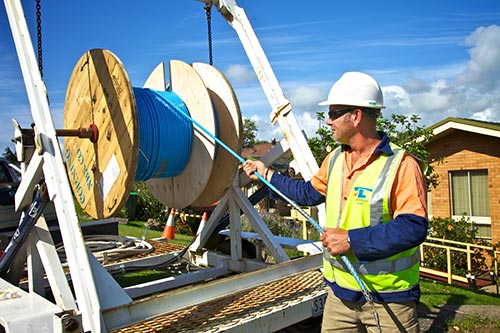
I write short articles as well as long feature “explainer” articles on topics including: Google Android Smartphones and Tablets, Space, Civil & Military Aviation, Ebooks and the Publishing Industry, Electric cars, Technology augmenting human capabilities etc for Geare Magazine. The editor of GEARE has kindly permitted me to post articles here after the magazine issue the article was printed in has passed its shelf life. I have added updates where new information is relevant.
If you’ve driven between South Australia and the Northern Territory, most likely you used the Stuart Highway, named in honour of John McDouall Stuart, the Australian explorer who led the first European expedition to cross the Australian continent south to north and back. And he did so without losing a member of his team.
His path through the arid centre of Australia was crucial to the construction of the Overland Telegraph, built by the South Australian government to increase the economic prosperity of the state. Prior to this, news travelled by horse, ship and mail coach.
As an example, Charlotte, Princess of Wales, died on 5 November 1817. Her death was reported in Australian newspapers as soon as they learned of it in the first few days of April 1818.
The Overland Telegraph connected Australia to the world, turning that five-month delay into a matter of hours. It’s hard to conceive the effect this must have had on all manner of business, trade and government.
If the NBN is built across Australia as planned, this new broadband infrastructure could be just as revolutionary as the Overland Telegraph was in its day. In urban areas we may tend to be blasé about its goals for download speeds, only an order or so higher than what many can already achieve.
By enabling efficiencies across the economy, making rural/regional cities more competitive with capital cities, the NBN could potentially transform many aspects of our lives, including working from home, education, health, government and business services.
This future is, however, politically uncertain. If the Liberal/National party coalition wins the next federal election, they promise not to “rip up” already-built areas but have indicated their intent is to stop building the NBN almost immediately and support a mishmash of cheaper, slower technologies instead.
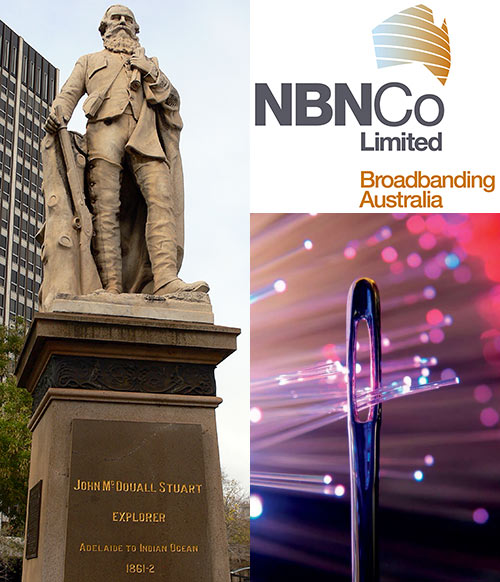
NBN Objectives
The key objectives of the NBN are threefold:
Firstly homes, schools and workplaces in towns with population of 1000+ should be connected to optical-fibre broadband delivering 100 megabits per second (Mbps) speeds. This should represent around 93% of the population.
The remaining 7% of Australia is promised 12Mbps speeds delivered via next-generation wireless and satellite. Linking all this will be Australia’s first national wholesale-only, open-access broadband network of fibre-optic cable connecting cities, major regional centres and rural towns.
Internet service providers (ISPs) who resell the NBN have been given a set of standard plans to offer their customers. But are these speeds realistic?
| Download speed (Mbps) | Upload speed (Mbps) | |
|---|---|---|
| Option 1 (base level) | 12 | 1 |
| Option 2 | 25 | 5 |
| Option 3 | 50 | 20 |
| Option 4 | 100 | 40 |
If you currently have ADSL2+, you may be aware that the further you are from the phone exchange (and the older your copper phone line), the slower and more unreliable your internet connection will be. Very few people get the advertised top download speeds of 24Mbps.
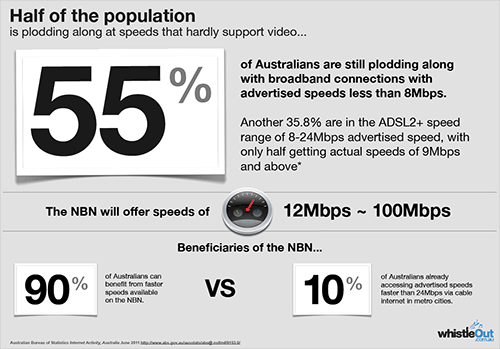
Note: the Infographic says 10% of Australians are already accessing advertised speeds faster than 24Mbps via cable internet in metro areas. Perhaps 10% could *potentially* do so but in reality a much smaller % of people are signed up for Telstra/Optus Cable.
With NBN fibre things are different. It doesn’t matter how far away you are from the nearest telecommunications exchange. You should actually get the full advertised NBN speed.
And while the top speed for the initial retail NBN launch will be 100Mbps download and 40Mbps upload, the beauty of fibre technology is that top speeds can be increased for relatively minimal investment. The NBN is being built with 1000Mbps download speed as the planned next step; indeed this will be available even at roll-out for some organisational clients.
Copper Is Not Good Enough
Opposition telecommunications spokesperson Malcolm Turnbull says the demand for universal 100Mbps fibre internet simply isn’t there. He’s missing the point. At the moment there may be no specific product/service likely to suck up such speeds. But content and devices follow the capability of the network. These will rapidly be created and widely implemented once people have signed up with these speeds.
David Braue says the Liberal/National coalition anti-NBN argument is made even weaker with “hysterical, incorrect and frankly offensive discourse that overstates the NBN’s problems and makes a mockery of their new complaints that they’re not getting broadband fast enough”.
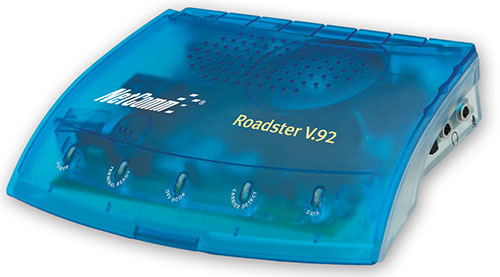
I can remember dialling into the internet 10 years ago using a Netcomm Roadster II 56, its semitransparent blue clamshell shape indicating its status as the premium ‘speed demon’ modem for those who wanted top performance. Back then there were people who thought 50kbps was “enough”.
A decade later this article was being written using a 10Mbps ADSL2+ internet connection (200 times faster), and even that is regularly pushed to its limits – a quarter of its bandwidth taken up by FetchTV (internet pay TV), plus uploading backup data to cloud storage, two VoIP phonelines and the other various devices connected to the router via switch or WiFi, all accessing the internet. And this is a household without an iPad or games consoles like the XBOX or PS3. A household of several people could easily make use of a 50 or 100Mbps NBN connection with today’s gadgets and internet services.
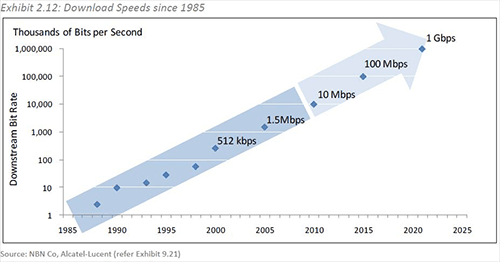
In late 2003 Telstra executive Tony Warren told Senate Estimates:
“I think it is right to suggest that ADSL is an interim technology. It is probably the last sweating, if you like, of the old copper network assets. In copper years, if you like, we are at a sort of transition – we are at five minutes to midnight.”
The key parts of the federal government’s NBN deal with Telstra are:
Telstra has now agreed to lease the ducts and pits that were in place for its copper access network, and provide NBN Co with access to its dark fibre and exchanges for a minimum of 35 years. This means that NBN Co doesn’t need to dig new pits and ducts down every street where fibre is being laid, or install all new fibre backhaul and building exchanges. The total cost to NBN Co for this portion of the deal is $4 billion to be paid out over the next 30 years.
…
Telstra has agreed to decommission its copper network in the areas covered by fibre as the NBN is rolled out. NBN Co will pay the company $5 billion over the next 10 years, with payments made as customers are disconnected and transferred onto the NBN.
There are those who argue that new developments may allow copper to improve performance to near-fibre speeds but any argument that the copper phone network is “good enough” seems shortsighted, and will be rendered redundant once the copper network is shut down, leaving the NBN to provide phone, internet, TV and other services.
Cost of the NBN
Billion-dollar budgets are difficult to put into meaningful perspective. It is perhaps useful to compare with spending on another area, perhaps roads, since the NBN will be the virtual road network for Australian people and businesses.
Budget papers show that the federal Labor government plans to spend “$27.7 billion on roads over six years (2008-09 to 2013-14)… with the states and territories contributing a further $6 billion”, making a total of $33.7 billion.
NBN Co., the company set up by the federal government to be in charge of planning and building the NBN, told me that the federal government plans to invest $26 billion in the NBN with “remaining funds needed to build the network and fund the company… from NBN Co’s own revenues and, at an appropriate time, the private debt markets.”
Costs of signing up for an NBN service remain undefined. However recent analysis by Whistleout shows that “Many NBN plans will be cheaper than many of today’s ADSL 2+ bundle plans. From those ISPs that have announced consumer pricing, the underlying price of their NBN plans is actually cheaper per GB than their monthly ADSL & line rental equivalent plans (monthly line rental will not be required on the NBN).”
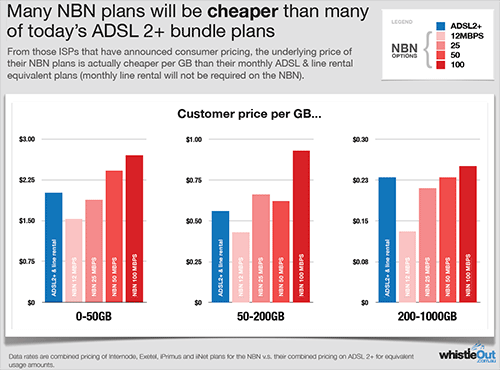
Private Build
Why not let private internet service providers build the NBN? There are plenty of innovative ISPs in the Australian market place, including iiNet and Internode.
Understandably, however, they will invest in infrastructure only in geographic areas likely to make profits for their owners. Proof of this can be seen in the cable TV and internet networks built in the mid 1990s by Optus and Telstra. They were free to install them where they wished, so Telstra overlapped Optus by about 80%, and the Optus network proved unprofitable. The result was cable TV and internet access to less than three million households, mostly in Eastern Australia, at a consumer price so high that only about third of eligible households signed up.
NBN Connection – Opt In or Opt Out?
The overall NBN would be most cost-effective and efficient if connection to the side of the building was mandatory to every home and business, just like water, electricity and sewage systems. The second best option would be for a “opt out” default, so everyone is connected by default unless a potential customer formally asks beforehand not to be.
Currently, when the NBN installs its fibre to the side of your home/work building, you get the choice of whether to activate a service on it or not. The cost is nothing until you sign up with an NBN retail ISP.
The Whirlpool.net.au Australian Broadband Survey for 2011 included several questions about the NBN. Results included 69.9% of the 23,513 participants saying they would ensure their house/unit is included in the NBN rollout, and 45% saying they support the opt-out policy for the NBN roll-out (with 20% voting against and almost 35% undecided or not fully understanding the options).
The Tasmanian Labor/Greens coalition government has decided to let NBN Co. install connections there on an ‘opt-out’ basis. However, the new Victorian and NSW Liberal/National governments favour ‘opt in’.
Next-Generation Fast Wireless
I get to test all the next-generation wireless internet options, so can tell you that these services should prove a useful complement to the NBN, especially while commuting or working out of office. But wireless is not a viable alternative – prone to unpredictability, with speeds depending on how heavily other wireless users in your area are accessing the service.
Renai Lemay makes this point well in his article Reality check: Telstra 4G not aimed at the NBN
“Most of the heavy mobile broadband users which Telstra is attempting to shift onto its fledgling 4G network will be the sort of users who will have both fixed and mobile broadband connections . They’re internet junkies (I speak from personal experience). A small subset of the light to moderate users won’t sign up for the NBN fibre when it’s eventually rolled out in their neighbourhood, but only a small percentage.”
NBN Trial Area – First User Experiences
NBN Co.’s first release sites are Part of the suburb of Brunswick in Melbourne, VIC; Parts of the suburbs of Aitkenvale and Mundingburra in Townsville, QLD; The coastal communities of Minnamurra and Kiama Downs south of Wollongong, NSW; An area of west Armidale, NSW, including the University of New England; and The rural town of Willunga in South Australia.
Warren Cheetham lives in the NBN trial area of Townsville, QLD. He told me:
“I’ve been keenly observing concerted rollout activity in my area since late 2010 by NBN contractor Ergon Energy, with cables being deployed to homes in April. I’m very excited to see the infrastructure being built, and am prepared to wear any teething problems in order to see what the technology will do. I’m also very excited about the strategic role the NBN can play in developing social, cultural and economic life in our regional city.
The main thing we are looking forward to it the changes to the way we purchase and use movies and music. The potential to purchase or rent digital content and download it in a timely manner is enormous. The other main benefit we can see is the increased potential to work from home, and to engage in online training and education from home.”
Marcus Westbury is a broadcaster, writer, media maker and festival director who lives in the Melbourne NBN trial area.
He told me that:
“The NBN will be the largest cultural infrastructure project Australia has ever undertaken. It will change a lot about how we create and consume culture in Australia.
Within a decade, practically every home, every cultural institution, every venue, large and small, will be connected. They will all have the capacity to distribute film, sound, video, music, literature, images and media of incredible quality at lightning speeds to anywhere in the country and most of the world.
The NBN is a once-in-a-generation opportunity. To take it, we need to sweep aside an inherited complexity of ageing legal structures, outdated logics and vested interests.”
A Faster Future
This article has looked at the progress rather than potential of the NBN. If you’re intrigued about the possible new broadband applications and services, I recommend that you read A Faster Future by Brad Howorth and Janelle Ledwidge. It informs readers swiftly and well, while maintaining a Hitchhikers Guide attitude of “Don’t Panic”.
This article was originally published in GEARE Magazine issue #66. It is “digitally reprinted” here with permission from the editor. I have added updates where new information is relevant.


Leave a Reply